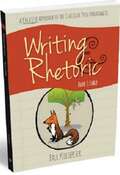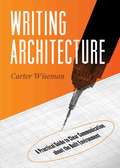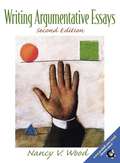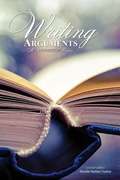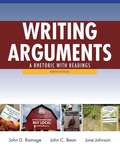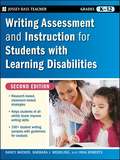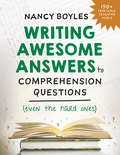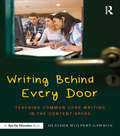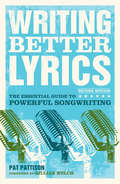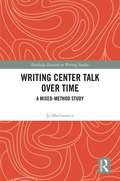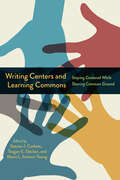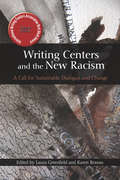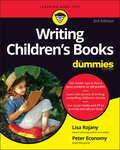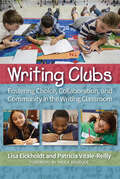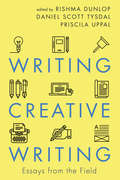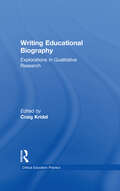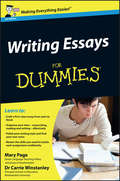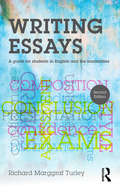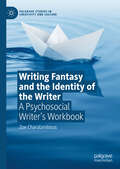- Table View
- List View
Writing And Rhetoric Book 1: Student
by Paul KortepeterA Creative Approach to the Classical Progymnasmata- Think of the progymnasmata as a step-by-step apprenticeship in the art of writing and rhetoric. What is an apprentice? It is a young person who is learning a skill from a master teacher. Our students will serve as apprentices to the great writers and great stories of history. Students are often expected to write with no clear model before them.Modern composition scolds traditional writing instruction as rote and unimaginative.It takes imitation to task for a lack of freedom and personal expression.And yet, effective communication from writer to reader always requires some sort of form and structure.Many of historys greatest writers learned by imitation.In other words, writing takes the same kind of determined study as ballet or diving.Creativity uses conventional form as a stage or a springboard from which to launch grand jetes and somersaults. Too often students are expected to tackle complex writing assignments without learning the necessary intermediate steps.The assumption is that because most everyone can speak English well enough to be understood, and form letters with a pencil, that everyone should be able to write well.Yet how many of us would expect a child to sit at a piano, without piano lessons, and play a concerto?Writing is never automatic. The Writing & Rhetoric seriesmethod employsfluent reading, careful listening, models for imitation, and progressive steps.It assumes that students learn best by reading excellent, whole-story examples of literature and by growing their skills through imitation. Each exercise is intended to impart a skill (or tool) that can be employed in all kinds of writing and speaking.The exercises are arranged from simple to more complex. Whats more, the exercises are cumulative, meaning that later exercises incorporate the skills acquired in preceding exercises.This series is a step-by-step apprenticeship in the art of writing and rhetoric. Fable, the first book in the Writing & Rhetoric series, teaches students the practice of close reading and comprehension, summarizing a story aloud and in writing, and amplification of a story through description and dialogue.Students learn how to identify different kinds of stories;determine the beginning, middle, and end of stories;recognize point of view; and see analogous situations, among other essential tools. The Writing & Rhetoric seriesrecovers aproven method of teaching writing, using fables to teach beginning writers the craft of writing well.This is the first in a series of twelve books that will train students over six years, starting in grades three or four and up.
Writing Architecture
by Carter WisemanFor ages, architects have been criticized for speaking an insular language, known to some as "archispeak." Writing Architecture considers the process, methods, and value of architecture writing based on Carter Wiseman's 30 years of personal experience in writing, editing, and teaching in young architects how to write. This book creatively tackles a problematic issue that Wiseman considers to be a crucial characteristic of successful architecture writing: clarity of thinking and expression. He argues that because we live our lives within the built environment, architecture is the most comprehensive and complex of all art forms. Even brilliantly inspired and complex architectural structures would only amount to misunderstood abstractions without the support and reinforcement of the clear explanation.Written as a primer for both college level students and practitioners, Writing Architecture acknowledges and explores the boundaries between different techniques of architecture writing from myriad perspectives and purposes. A poetic description of the beauty and impact of a bridge will not illuminate the mechanical knowledge housed in the structure, but at the same time, dense architectural theory will not encourage individuals experiencing and supporting the bridge to perceive significance and usefulness in the design. Using excerpts and from writers in different genres and from different historical periods, Wiseman offers a unique and authoritative perspective on comprehensible writing skills needed for success.
Writing Architecture
by Carter WisemanFor ages, architects have been criticized for speaking an insular language, known to some as "archispeak." Writing Architecture considers the process, methods, and value of architecture writing based on Carter Wiseman's 30 years of personal experience in writing, editing, and teaching in young architects how to write. This book creatively tackles a problematic issue that Wiseman considers to be a crucial characteristic of successful architecture writing: clarity of thinking and expression. He argues that because we live our lives within the built environment, architecture is the most comprehensive and complex of all art forms. Even brilliantly inspired and complex architectural structures would only amount to misunderstood abstractions without the support and reinforcement of the clear explanation.Written as a primer for both college level students and practitioners, Writing Architecture acknowledges and explores the boundaries between different techniques of architecture writing from myriad perspectives and purposes. A poetic description of the beauty and impact of a bridge will not illuminate the mechanical knowledge housed in the structure, but at the same time, dense architectural theory will not encourage individuals experiencing and supporting the bridge to perceive significance and usefulness in the design. Using excerpts and from writers in different genres and from different historical periods, Wiseman offers a unique and authoritative perspective on comprehensible writing skills needed for success.
Writing Argumentative Essays (Second Edition)
by Nancy V. WoodThis unique rhetoric/reader helps readers develop strategies for critical reading, critical thinking, research, and writing that will help them argue clearly and convincingly in all types of argument. It shows how to identify and develop arguments, read and form reactions and opinions, analyze an audience, seek common ground, and use a wide, realistic range of techniques to write argument papers that express their individual views and original perspectives on modern issues. <P><P> Includes clear explanations and examples of argument theory and reading and writing processes, research and documentation skills, and offers a variety of writing activities for developing the exploratory paper, position paper, researched position paper, and the Rogerian argument paper. Unique chapters discuss argument styles (including cross-gender and cross-cultural communication styles), Rogerian argument, and argument and literature. 49 Essays for Analysis (several in each chapter) cover several broad issue areas and sub-issues concerning families, education, crime and the treatment of criminals, computers, race and culture in America, genetic engineering, and social responsibility.
Writing Arguments: A Rhetoric And Reader
by Brenda Herbert HarkerA reading companion for both the teachers and the students as they pursue the argumentative writing course; equipped with essays with different styles selected for viewpoint and meaning.
Writing Arguments: A Rhetoric with Readings, Ninth Edition
by John D. Ramage June Johnson John C BeanThe market-leading guide to arguments, Writing Arguments ,9/e has proven highly successful in teaching readers to read arguments critically and to produce effective arguments of their own.
Writing Assessment and Instruction for Students with Learning Disabilities
by Nancy Mather Barbara J. Wendling Rhia RobertsIt Contains strategies for working with all students that struggle with writing, Offers classroom-tested strategies, helpful information, 100+writing samples with guidelines for analysis, and handy progress-monitoring charts, Includes ideas for motivating reluctant writers, Mather is an expert in the field of learning disabilities.
Writing Awesome Answers to Comprehension Questions (Even the Hard Ones)
by Nancy BoylesHelp students appreciate texts and write about them with conviction. Responding to a comprehension question is a surprisingly complex task. It draws on multiple skills: students must be able to read and analyze a text passage; consider what aspect of the text the question addresses; and then quickly and concisely write about their ideas, citing evidence to support them. Hence the prominence of constructed-response questions in standardized testing. In this refreshingly clear and upbeat guide, literacy consultant Nancy Boyles gives a step-by-step demonstration of how to help students achieve success with this task—and in the process of unpacking the steps involved, demonstrates how the instruction can inspire teachers’ creativity as well as deepen students’ literacy skills. Filled with ready-to-use scaffolds for every stage of instruction—sets of sample questions, anchor charts, cue cards, answer frames—this is a one-stop resource for teaching students how to organize their thoughts about what they’ve read, and then set them down in writing.
Writing Behind Every Door: Teaching Common Core Writing in the Content Areas
by Heather Wolpert-GawronFor students to become college-ready writers, they must be exposed to writing throughout the school day, not just in English class. This practical book shows teachers in all subject areas how to meet the Common Core State Standards and make writing come alive in the classroom. Award-winning educator Heather Wolpert-Gawron provides effective and exciting ideas for teaching argument writing, informational writing, project-based writing, and writing with technology. Each chapter is filled with strategies, prompts, and rubrics you can use immediately. Special Features: A variety of writing strategies that work in any subject area Tips for developing meaningful prompts Diagrams and templates that you can use with your students Rubrics for assessing writing, as well as ideas for having students create their own rubrics Samples of student work in different formats Ideas for teaching students to break the Google homepage habit and conduct effective research Cross-curricular writing assignments for science, history, ELA, electives, and PE Suggestions for teaching summary writing, an essential academic skill Ideas for staff professional development on Common Core writing
Writing Better Lyrics Second Edition: Essential Guide To Lyric Form And Structure: Tools And Techniques For Writing Better Lyrics (Songwriting And Lyrics Ser.)
by Pat PattisonPattison presents a unique, in-depth approach to the process of lyric writing. Songwriters will examine 17 extraordinary songs and learn the distinct elements that make them so effective. Pattison then presents more than 30 lyric-writing exercises designed to achieve the same results. From generating lyric ideas and managing repetition to developing verses, it's all here. Songwriters will: find warm-up exercises that revolutionize songwriting imagery; use a rhyming dictionary and a thesaurus to generate ideas and find snappy rhyme; create meaningful metaphors and similes while avoiding cliches; develop verses by using or breaking conventional rules; experiment with point of view in every lyric to make a song stand out
Writing Center Talk over Time: A Mixed-Method Study (Routledge Research in Writing Studies)
by Jo MackiewiczIn the last 15 to 20 years, writing centers have placed greater importance on tutor training, focusing on teaching tutors best practices in fostering student writers’ engagement and writing skills. Writing Center Talk over Time explores the importance of writing center talk and demonstrates the efficacy of tutor training. The book uses corpus-driven analysis and discourse analysis to examine the changes in writing center talk over time to provide a baseline understanding of the very heart of writing center work: the talk that unfolds between tutors and student writers. It is this talk that, at its best, motivates student writers to continue to improve their writing and scaffolds their learning and that makes tutors proud of the service that they provide. The methods and analysis of this study are intended to inform other researchers so that they may conduct further research into the efficacy of writing center talk.
Writing Centers and Learning Commons: Staying Centered While Sharing Common Ground
by Steven J. Corbett Teagan E. Decker Maria L. L. Soriano YoungWriting Centers and Learning Commons presents program administrators, directors, staff, and tutors with theoretical rationales, experiential journeys, and go-to practical designs and strategies for the many questions involved when writing centers find themselves operating in shared environments. The chapters comprehensively examine the ways writing centers make the most of sharing common ground. Directors, coordinators, administrators, and stakeholders draw on past and present attention to writing center studies to help shape the future of the learning commons and narrate their substantial collective experience with collaborative efforts to stay centered while empowering colleagues and student writers at their institutions. The contributors explore what is gained and lost by affiliating writing centers with learning commons, how to create sound pedagogical foundations that include writing center philosophies, how writing center practices evolved or have been altered by learning center affiliations, and more. Writing Centers and Learning Commons is for all stakeholders of writing in and across campuses collaborating on (by choice or edict), or wishing to explore the possibilities of, a learning commons enterprise. Contributors: Alice Batt, Cassandra Book, Charles A. Braman, Elizabeth Busekrus Blackmon, Virginia Crank, Celeste Del Russo, Patricia Egbert, Christopher Giroux, Alexis Hart, Suzanne Julian, Kristen Miller, Robby Nadler, Michele Ostrow, Helen Raica-Klotz, Kathleen Richards, Robyn Rohde, Nathalie Singh-Corcoran, David Stock
Writing Centers and the New Racism: A Call for Sustainable Dialogue and Change
by Greenfield, Laura; Rowan, KarenNoting a lack of sustained and productive dialogue about race in university writing center scholarship, the editors of this volume have created a rich resource for writing center tutors, administrators, and scholars. Motivated by a scholarly interest in race and whiteness studies, and by an ethical commitment to anti-racism work, contributors address a series of related questions: How does institutionalized racism in American education shape the culture of literacy and language education in the writing center? How does racism operate in the discourses of writing center scholarship/lore, and how may writing centers be unwittingly complicit in racist practices? How can they meaningfully operationalize anti-racist work? How do they persevere through the difficulty and messiness of negotiating race and racism in their daily practice? The conscientious, nuanced attention to race in this volume is meant to model what it means to be bold in engagement with these hard questions and to spur the kind of sustained, productive, multi-vocal, and challenging dialogue that, with a few significant exceptions, has been absent from the field.
Writing Centers at the Center of Change (Routledge Research in Writing Studies)
by Joe Essid Brian McTagueWriting Centers at the Center of Change looks at how eleven centers, internationally, adapted to change at their institutions, during a decade when their very success has become a valued commodity in a larger struggle for resources on many campuses. Bringing together both US and international perspectives, this volume offers solutions for adapting to change in the world of writing centers, ranging from the logistical to the pedagogical, and even to the existential. Each author discusses the origins, appropriate responses, and partners to seek when change comes from within a school or outside it. Chapters document new programs being formed under changing circumstances, and suggest ways to navigate professional or pedagogical changes that may undermine the hard work of more than four decades of writing-center professionals. The book’s audience includes writing center and learning-commons administrators, university librarians, deans, department chairs affiliated with writing centers. It will also be useful for graduate students in composition, rhetoric, and academic writing.
Writing Children's Books For Dummies
by Peter Economy Lisa RojanyCreate the next very hungry caterpillar, big red dog, or cat in the hat with a hand from this trusted guide In Writing Children’s Books For Dummies, you’ll learn what to write between “Once upon a time . . .” and “The End” as you dive into chapters about getting started writing, how to build great characters, and how to design a dramatic plot. On top of the technical writing advice, you’ll discover how talented illustrators work and how to find an agent. The newest edition of this popular For Dummies title even shows you how to choose a publisher—or self-publish—and how to use social media and other marketing and PR to get the word out about your new masterpiece. In the book, you’ll learn about: The fundamentals of writing for children, including common book formats and genres, and the structure of the children’s book market Creating a spellbinding story with scene description, engaging dialogue, and a child-friendly tone Polishing your story to a radiant shine with careful editing and rewriting Making the choice between a traditional publisher, a hybrid publisher, or self-publishing Using the most-effective marketing and publicity techniques to get your book noticed Perfect for anyone who’s ever dreamed of creating the next Ferdinand the Bull or Grinch, Writing Children’s Books For Dummies is an essential, easy-to-read guide for budding children’s authors everywhere.
Writing Clubs: Fostering Community, Collaboration, and Choice in the Writing Classroom
by Lisa Eickholdt Patricia Vitale-ReillyAsk teachers about their biggest challenges in elementary and middle school, and many will say the teaching of writing. It is often difficult for students find the joy, discovery, and satisfaction writing can yield. What Lisa Eickholdt and Patricia Vitale-Reilly have found is that adherence to genre studies can get in the way of student collaboration. Believing writing instruction should be more authentic, they want students to have more choices, develop better collaboration, and sustain a sense of community, all through the implementation of writing clubs.In their book Writing Clubs: Fostering Choice, Collaboration, and Community in the Writing Classroom , you'll discover ways to: Collaborate throughout the process of writing Choose what to write and how to write it Examine mentor texts and study craft techniques across genres Develop speaking and listening skills Celebrate classmates&’ accomplishments through publication Collaboration is widely recognized as a vital life skill. Eickholdt and Vitale-Reilly present a plethora of ideas on how gratifying it can be right now, as well as in the future. There&’s an old proverb that says, &‘If you want to go fast, go alone. If you want to go far, go with others.&’ In Writing Clubs , we discover that there is no limit to how far young writers can go when teachers show them what it means to collaborate.
Writing Companion, Grade 6
by Perfection LearningThe first chapter of this book provides instruction and activities to help develop the characteristics of good writing listed above. Each of the next five chapters focuses on a different type of writing. In each of these five chapters, the first several lessons highlight the elements particularly important to one type of writing. For example, the chapter on arguments includes lessons that focus on claims and counterclaims. The next-to-last lesson in each chapter takes you, step-by-step, through writing a text. Built into these lessons are instruction and practice in grammar and usage that address the most common writing problems. The final lesson in each chapter provides prompts for you to demonstrate your skills in gathering, analyzing, and using information in your writing. This lesson ends with a checklist based on the characteristics of good writing.
Writing Companion, Grade 8
by Perfection LearningThe first chapter of this book provides instruction and activities to help develop the characteristics of good writing listed above. Each of the next five chapters focuses on a different type of writing. In each of these five chapters, the first several lessons highlight the elements particularly important to one type of writing. For example, the chapter on arguments includes lessons that focus on claims and counterclaims. The next-to-last lesson in each chapter takes you, step-by-step, through writing a text. Built into these lessons are instruction and practice in grammar and usage that address the most common writing problems. The final lesson in each chapter provides prompts for you to demonstrate your skills in gathering, analyzing, and using information in your writing. This lesson ends with a checklist based on the characteristics of good writing.
Writing Companion, High School Level-B
by Perfection LearningThe first chapter of this book provides instruction and activities to help develop the characteristics of good writing listed above. Each of the next five chapters focuses on a different type of writing. In each of these five chapters, the first several lessons highlight the elements particularly important to one type of writing. For example, the chapter on arguments includes lessons that focus on claims and counterclaims. The next-to-last lesson in each chapter takes you, step-by-step, through writing a text. Built into these lessons are instruction and practice in grammar and usage that address the most common writing problems. The final lesson in each chapter provides prompts for you to demonstrate your skills in gathering, analyzing, and using information in your writing. This lesson ends with a checklist based on the characteristics of good writing.
Writing Creative Writing: Essays from the Field
by Priscila Uppal Rishma Dunlop Daniel Scott TysdalEssential and engaging essays about the joys and challenges of creative writing and teaching creative writing by a host of Canada’s leading writers. Writing Creative Writing is filled with thoughtful and entertaining essays on the joys and challenges of creative writing, the complexities of the creative writing classroom, the place of writing programs in the twenty-first century, and exciting strategies and exercises for writing and teaching different genres. Written by a host of Canada’s leading writers, including Christian Bök, Catherine Bush, Suzette Mayr, Yvette Nolan, Judith Thompson, and thom vernon, this book is the first of its kind and destined to be a milestone for every creative writing student, teacher, aspirant, and professional.
Writing Education Research: Guidelines for Publishable Scholarship
by Joy Egbert Sherry SandenFor both new academics and those with some experience, writing articles of publishable quality can be particularly challenging. Developing the necessary skill set requires useful information, hard work, and the type of direction infrequently offered in research methods courses, leaving researchers to piece together resources on their own. This book addresses this critical topic in a format that is easy to teach and understand. It is a practical volume that teaches researchers how to identify their audience, clearly state the nature of their work, provide exceptional literature reviews, cite appropriately, and explicate their research. Beginning each chapter with reviewer comments, Writing Education Research is designed to help scholars understand both how to write effective research reports and how to get published. Practice exercises and resource lists in each chapter offer easy-to-access information about the review and publication process. A perfect accompaniment to standard research courses, this practical book demystifies the writing process for anyone looking to publish articles, chapters, or papers in education.
Writing Educational Biography: Explorations in Qualitative Research (Critical Education Practice #Vol. 13)
by Craig KridelFirst Published in 1998. Routledge is an imprint of Taylor & Francis, an informa company.
Writing Essays For Dummies
by Mary Page Carrie WinstanleyDo ever wish that you could write the perfect university essay? Are you left baffled about where to start? This easy-to-use guide walks you through the nuts and bolts of academic writing, helping you develop your essay-writing skills and achieve higher marks. From identifying the essay type and planning a structure, to honing your research skills, managing your time, finding an essay voice, and referencing correctly, Writing Essays For Dummies shows you how to stay on top of each stage of the essay-writing process, to help you produce a well-crafted and confident final document.Writing Essays For Dummies covers:Part I: Navigating a World of Information Chapter 1: Mapping Your Way: Starting to Write EssaysChapter 2: Identifying the essay typePart II: Researching, Recording and ReformulatingChapter 3: Eyes Down: Academic reading Chapter 4: Researching OnlineChapter 5: Note-taking and Organising your Material Chapter 6: Avoiding Plagiarism Part III: Putting Pen to Paper Chapter 7: Writing as a process Chapter 8: Getting Going and Keeping Going Part IV: Mastering Language and Style Chapter 9: Writing with ConfidenceChapter 10: Penning the Perfect Paragraph Chapter 11: Finding Your Voice Part V: Tightening Your Structure and OrganisationChapter 12: Preparing the Aperitif: The Introduction Chapter 13: Serving the Main Course: The Essay's Body Chapter 14: Dishing up Dessert: The Conclusion Chapter 15: Acknowledging Sources of Information Part VI: Finishing with a Flourish: The Final TouchesChapter 16: It's all in the detail Chapter 17: Perfecting Your Presentation Chapter 18: The afterglow Part VII: Part of Tens Chapter 19: Ten Tips to Avoid Things Going Wrong Chapter 20: Ten Ways to Make Your Essay Stand Out
Writing Essays: A guide for students in English and the humanities
by Richard Marggraf TurleyEssays are a major form of assessment in higher education today and this is a fact that causes some writers a great deal of anxiety. Fortunately, essay writing is a skill that can be learned, like any other. Through precise explanations, this fully updated edition of Writing Essays gives you the confidence to express yourself coherently and effectively. It demystifies the entire process of essay writing, helping you to become proficient and confident in every aspect. Writing Essays reveals the tricks of the trade, making your student life easier. You’ll learn how to impress tutors by discovering exactly what markers look for when they read your work. Using practical examples selected from real student assignments and tutor feedback, this book covers every aspect of composition, from introductions and conclusions, down to presentation and submission. It also advises you on stress-free methods of revision, helps with exam essays, explains the principles of effective secondary source management, and shows you how to engage meaningfully with other critics’ views. A new chapter will also guide you through the intricacies of the undergraduate dissertation. As a full-time university professor, Richard Marggraf Turley counsels students and assesses their work every day, helping him to recognise the challenges that they face. Accessible, concise and full of practical examples, Writing Essays is a response to these challenges and will be an invaluable companion for Humanities students who wish to improve their grades and become confident in the art of essay writing.
Writing Fantasy and the Identity of the Writer: A Psychosocial Writer’s Workbook (Palgrave Studies in Creativity and Culture)
by Zoe CharalambousThis book presents the innovative pedagogy of Writing Fantasy: a method for exploring and shifting one’s identity as a writer. The book draws on qualitative research with undergraduate creative writing students and fills a gap in the literature exploring creative writing pedagogy and creative writing exercises. Based on the potential to shift writer identity through creative writing exercises and the common ground that these share with the stance of the Lacanian analyst, the author provides a set of guidelines, exercises and case studies to trace writing fantasy, evidenced in one’s creative writing texts and responses about creative writing. This innovative work offers fresh insights for scholars of creativity, Lacan and psychosocial studies, and a valuable new resource for students and teachers of creative writing.
